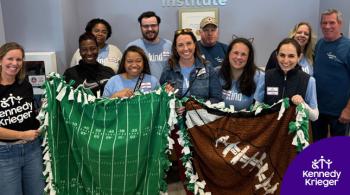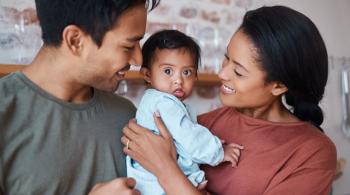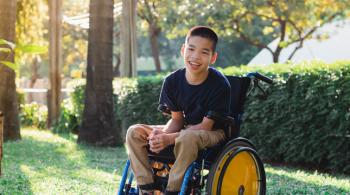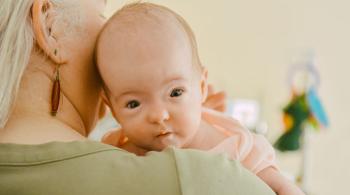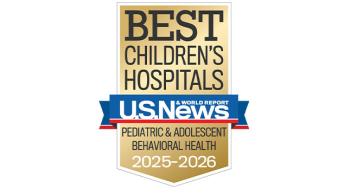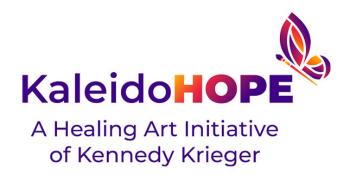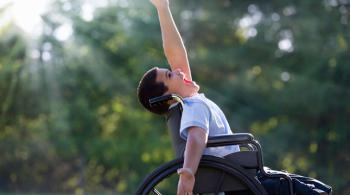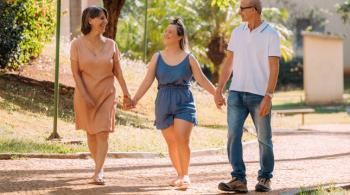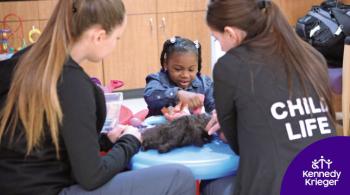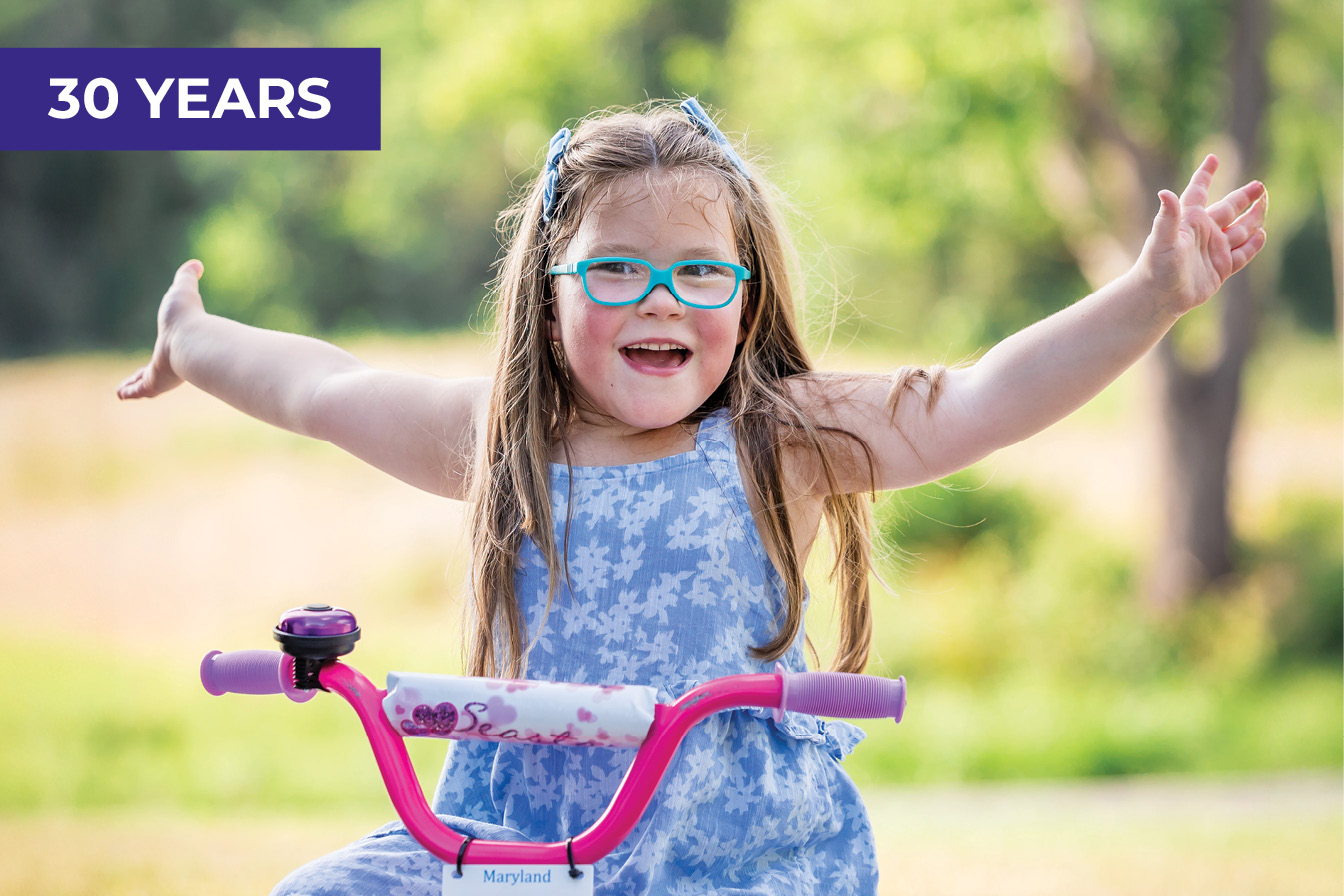
Natalie
By Laura Thornton
Natalie, 6, loves swimming, riding her bike and playing with her sister. In the pool, she likes pretending she’s a mermaid. But a few months after she was born, her parents noticed that the left side of her body wasn’t moving quite as much as the right.
Doctors at Kennedy Krieger Institute’s Infant Neurodevelopment Center diagnosed her with cerebral palsy when she was 8 months old, and referred her to the Institute’s Specialized Transition Program (STP), a neurorehabilitation day hospital, for daily therapies to strengthen her left side.
“I honestly believe that without the intensive therapies at Kennedy Krieger, Natalie probably wouldn’t have developed left-side motor skills at all,” says her mom, Crystal.
For a month, Natalie and Crystal met with STP occupational therapist Nicole Andrejow for an hour of constraint-induced movement therapy (CIMT) each weekday. Natalie wore a cast on her right arm to immobilize it, which encouraged her to use her left arm to, for example, reach for a favorite toy or practice rolling over. Sessions took place over Zoom, as the pandemic had just begun, and Crystal got a crash course in infant therapies. “I feel like I have an honorary therapy degree,” she says.
Interdisciplinary Care + School = A Winning Combo
For the past 30 years, the STP has been offering intensive, individualized, daily therapies for patients 8 months old through their early 20s. Serving 10 to 15 patients at a time, it offers physical, occupational and speech therapies, as well as counseling, neuropsychological assessment services and medical care. Patients typically come to the STP for four weeks at a time, for three to six hours a day. Between therapies, patients keep up with their schoolwork in the STP’s classroom.
It’s very rewarding to know Natalie is making progress and can have that sense of accomplishment.” – Crystal
“We’ve always had that academic component,” says STP Director Dr. Joan Carney, who founded the program in 1995. Before that, she was the special educator for the Institute’s inpatient rehabilitation hospital. She knew, firsthand, the challenges faced by young patients recently discharged from inpatient rehabilitation: They still need daily therapies, even if they don’t need 24/7 medical care, Dr. Carney explains.
The STP was one of the first in the country to offer pediatric day rehabilitation with an educational component. To this day, it remains one of the few centers in the U.S. offering such an important array of interdisciplinary services.
For occupational therapist Haley Holt, who’s been with the STP for nearly half of the program’s existence, “The interdisciplinary nature of the program was one of the big draws for me—the ability to collaborate with rehabilitation professionals from other fields to help each individual patient,” she says. “We’re not an isolated department.”
Initially, the STP served patients with brain injuries, patients with spina bifida, and patients who’d recently had orthopedic surgery. But over the years, the program has broadened in scope to serve young people with a variety of rehabilitative needs well-suited to intensive therapeutic intervention.
“We’ve grown a lot, in terms of looking at evidence-based protocols and outcomes for our patients, and then applying those protocols to serve kids with other conditions,” Andrejow says. “If a protocol is working for one group of patients, we’ll ask ourselves: ‘How would it work for other patients, too?’”
Since Natalie’s first month of CIMT, she’s returned to the STP for several more stints—in person. “She loves greeting her therapists and addressing them by first name,” Crystal says. Recently, to get ready for kindergarten, Natalie did a week of “summer camp” at the STP with a small group of peers. Therapists led the kids in fun activities designed to improve their motor skills.
“It’s very rewarding to know Natalie is making progress and can have that sense of accomplishment,” Crystal says. “We feel so fortunate that Natalie can have these experiences, thanks to Kennedy Krieger.”
Keeping Up With Zane
If the school successes of former patients of the STP are anything to go by, Natalie has an amazing school experience to look forward to. For example, Zane, 7, was a patient at the STP at age 2 after a sudden illness caused him to lose speech and gross and fine motor skills. He’s now a classroom leader and role model to his little sisters.
Shortly after Zane got sick, genetic testing revealed he had Aicardi-Goutières syndrome (AGS), a rare disease that can affect the brain’s white matter. His illness was most likely an overactive immune response caused by the AGS mutation, says his dad, Taibeen.
Zane began weekly therapy sessions with STP speech-language pathologist Lynnley Moore in May of 2020. “From the moment I met Zane, I knew he was a very capable, determined and creative child,” Moore says. “He was also very frustrated that he could not communicate his thoughts, feelings and ideas as clearly as he wanted to.”
Through a combination of weekly telehealth visits, in-person outpatient visits and an intensive bout of interdisciplinary care, Moore and others helped Zane learn how to use a tablet to communicate. By August of 2022, he was ready to transition to school-based services—because he was more than ready to begin pre-kindergarten. On his first day of school, Zane used the tablet to introduce himself to everyone—from his peers to the principal. At home, he uses the tablet to talk about his favorite movies, books and video games, and to bond with his siblings.
“His sisters are both talking at 100 mph,” says his mom, Mary. With his tablet, “Zane can get in there with them, in the talking and the bargaining and the rivalry.” When one of his sisters had her tonsils out and couldn’t speak for a few hours after waking up from surgery, she mimicked Zane’s nonverbal behavior to communicate, right down to his posture and facial expressions.
Zane’s teachers recently upgraded the keyboard on his tablet so it would keep pace with his developing vocabulary and communication needs. They also ordered a separate program for him to use on his tablet in Italian class—one that pronounces Italian words correctly. Other new programs allow Zane to do his schoolwork right on his tablet. And Zane has become his family’s documentarian, using the tablet to take family photos.
“We have three young kids, and we’re not always able to ‘capture the moment’ because we’re busy, but Zane can photograph us,” Taibeen says. “He likes photography and videography, so he takes photos of where we’re at. It’s a burgeoning thing.”
Zane returns to Kennedy Krieger once or twice a year for follow-up appointments. The Institute’s Seating Clinic updates his wheelchair as he grows and develops new skills. And because with AGS, there is the possibility that Zane could lose functioning again, Moore reevaluates Zane each year to track his progress and set a new baseline.
“It’s always a pleasure reevaluating Zane each summer and learning about his new adventures,” Moore says. “He’s an incredible reader and writer. He has a fabulous sense of humor, and he is still as determined as ever.”
“Kennedy Krieger was so helpful in setting a new path up for Zane,” Taibeen adds. “We’re so grateful to live nearby.”
‘Doing the Things He Loves’
Patients come to the STP from near and far. While Zane and his family live near Annapolis, Brayden, 19, traveled from Southern California at the age of 11 for rehabilitation at the STP after a snowboarding accident left him initially paralyzed from the neck down.
Before the accident, Brayden had been a competitive surfer for several years. He’d recently won the under-13 division of a surfing contest in his hometown of Laguna Beach and was looking forward to going pro. But when he came to Kennedy Krieger, he was still recovering from the paralysis, and he couldn’t move his right arm at all.
Occupational therapist Lindsey Harris suspected that was due to undiagnosed scar tissue that had formed in his right shoulder around a bone fracture. After surgery at Johns Hopkins to remove the scar tissue, Brayden did nearly three months of daily therapies at the STP, returning the next year for two months of a modified CIMT program. During both admissions, Brayden continued his schoolwork between therapy sessions so he wouldn’t fall behind in class.
Last June, Brayden graduated from high school, where he was on the surfing team for all four years. Now, he’s attending college, coaching young surfers and weighing a bid for the 2028 Paralympics in adaptive surfing.
Over the years, Brayden has kept up with his therapies, always working hard and giving it 110%, just as he does when he takes to the waves. He also enjoys cooking and origami, a relatively new hobby—two things that he wouldn’t have easily been able to do without Kennedy Krieger’s help all those years ago, says his mom, Denise.
“If Brayden hadn’t been at STP, he wouldn’t have gotten back the use of his right arm,” she says, explaining that while Brayden had to become left-handed after his accident, he can still use his right arm well enough to live independently and enjoy an active life. “We’re really grateful that he was able to go to Kennedy Krieger, and that he’s doing as well as he is, and doing the things he loves.”



